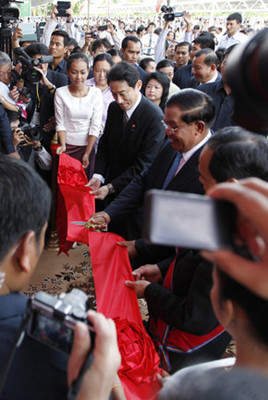Japanese investment in South-East Asia
東南亞地區(qū)的東瀛資本
Outward bound
向外拓展
A weak domestic economy is spurring Japanese firms to expand abroad
羸弱的國(guó)內(nèi)經(jīng)濟(jì)形勢(shì)鞭策著日本公司向海外進(jìn)軍
IT IS not every day that the opening of a shopping centre attracts a prime minister, but then Aeon Mall in Phnom Penh is not any old shopping centre. The Japanese-built complex is Cambodia's biggest, complete with an ice rink, television studio and bowling alley. For Hun Sen, the attending prime minister, it is a symbol of Japanese investment. Governments across South-East Asia are courting Japanese firms, and a torrent of yen is surging their way.
一間購(gòu)物商場(chǎng)的開(kāi)張剪彩吸引了國(guó)家首相的參與,這可不是天天都能看到的事情。不過(guò),位于金邊市的永旺購(gòu)物中心也不是一般的舊式商城。這間由日本人建造的綜合體是柬埔寨國(guó)內(nèi)規(guī)模最大的商城,其中還配備了溜冰場(chǎng)、電視演播室和保齡球場(chǎng)。對(duì)于這位參加了剪彩活動(dòng)的首相洪森來(lái)說(shuō),永旺購(gòu)物中心正是日本投資的象征。目前,東南亞各國(guó)政府都在極力討好日本公司,而與此同時(shí),后者也用大量的日元為自身鋪出了一條康莊大道。

Japanese investment in the region doubled to 2.3 trillion yen (24 billion) last year, the latest in a series of sizeable increases. Part of that is mergers and acquisitions by Japanese firms, which have skimped on investment at home and so have a cash hoard of some 229 trillion. SoftBank, a Japanese mobile carrier, just led a 100m investment in Tokopedia, an Indonesian e-commerce firm; Toshiba, a conglomerate, has pledged to invest 1 billion in South-East Asia over five years. A year ago Mitsubishi UFJ Financial Group, Japan's biggest bank, spent 536 billion to buy 72% of Thailand's Bank of Ayudhya.
日本人在東南亞地區(qū)的投資額連續(xù)大幅上漲,最新數(shù)據(jù)顯示,去年該指標(biāo)翻了一番,達(dá)到了2萬(wàn)3000億日元(約240億美元)。其中部分?jǐn)?shù)額是由日本公司所主導(dǎo)的企業(yè)吸收與合并產(chǎn)生的。這些公司省下了在日本國(guó)內(nèi)的投資款項(xiàng),從而囤積了約有229萬(wàn)億日元的現(xiàn)金儲(chǔ)備。在日本移動(dòng)通訊產(chǎn)業(yè)巨頭軟銀(SoftBank)的領(lǐng)投下,印尼電商平臺(tái)Tokopedia剛獲得了1億美元的融資;在過(guò)去的五年時(shí)間里,東芝集團(tuán)(Toshiba)已經(jīng)在東南亞許下了10億美元的投資承諾。而在一年前,三菱UFJ金融集團(tuán)(Mitsubishi UFJ Financial Group,日本規(guī)模最大的銀行)出資5360億日元,購(gòu)買了泰國(guó)大城銀行(Bank of Ayudhya)72%的股權(quán)。
During the first wave of Japanese investment, in the 1980s and 1990s, money poured into Thailand, Malaysia and Singapore, building up their automotive and electronics sectors. That flow largely ceased after the Asian financial crisis of 1997-98, when Japanese firms began to focus on China's vast, cheap labour force.
在第一次日本投資潮期間,即20世紀(jì)的80年代和90年代,資本涌入泰國(guó)、馬來(lái)西亞和新加坡,構(gòu)建了當(dāng)?shù)氐钠嚭碗娮赢a(chǎn)業(yè)。而大部分資金流在97至98年的亞洲金融危機(jī)后便隨之終止。從那時(shí)開(kāi)始,日本公司便將發(fā)展焦點(diǎn)轉(zhuǎn)移到了中土王國(guó),后者所擁有的勞動(dòng)力不僅規(guī)模龐大,其價(jià)格也十分低廉。
Yet with labour costs now steadily rising in China, and political tensions between Japan and China continuing to flare, South-East Asia looks attractive again. Japanese investment in China fell by nearly two-fifths last year, even as it grew in places like Cambodia. Although China is still Japan's biggest trading partner, Japanese firms invested nearly three times more in South-East Asia last year. For South-East Asian countries, too, Japan is an important hedge against China.
然而,隨著現(xiàn)在中土王國(guó)勞動(dòng)力成本節(jié)節(jié)攀升,同時(shí)中日兩國(guó)之間政治局勢(shì)也在持續(xù)緊張,東南亞地區(qū)便再次成了令人垂涎三尺的寶地。即便是在柬埔寨之類的地區(qū),去年的日本投資額也呈現(xiàn)出增長(zhǎng),但日方在華投資總額卻下降了約五分之二。雖然中土王國(guó)目前還是日本最大的貿(mào)易伙伴,但去年日本企業(yè)在東南亞地區(qū)的投資總額比在中土王國(guó)的數(shù)額高出了接近三倍。對(duì)于東南亞各國(guó)來(lái)說(shuō),與日本方面合作同樣也是一個(gè)抗衡中土王國(guó)的重要手段。
But the embrace of South-East Asia is not without its critics. Some worry that the headlong rush to the region by Japanese banks, in particular, may prove short-lived. In 2013 the Bank of Japan began buying bonds with newly created money (quantitative easing), as part of a plan by Shinzo Abe, the prime minister, to banish deflation and boost growth. The central bank's purchases left Japanese banks with lots of cash: they keep roughly 15% of their assets as excess reserves at the BoJ, earning minuscule returns. Since demand for loans in Japan is still subdued, they are hunting for borrowers abroad. Lending by Japanese banks to the rest of Asia, including China, has grown quickly since the end of 2012 and stood at 465 billion in June. But if Japan's monetary policy changes, such flows could reverse.
但是,一頭扎進(jìn)東南亞地區(qū)的策略也惹來(lái)了批評(píng)聲音。部分人士擔(dān)心,日本銀行不顧一切地涌入該地區(qū)的行為,尤其是對(duì)于銀行業(yè)來(lái)說(shuō),或許只是曇花一現(xiàn)。2013年,日本央行開(kāi)始用新印的鈔票購(gòu)買債券(量化寬松),而這正是日本首相安倍晉三(Shinzo Abe)消除通縮和刺激經(jīng)濟(jì)增長(zhǎng)計(jì)劃當(dāng)中的一部分。央行的債券購(gòu)入使得日本各大銀行擁有大量現(xiàn)鈔:他們只預(yù)留了15%左右的資產(chǎn)作為央行所需要的超額準(zhǔn)備金,而這是只能獲得極低回報(bào)的那部分。由于日本的貸款需求依舊疲弱,銀行們便把目光投向了海外市場(chǎng)。包括中土王國(guó)在內(nèi),日本銀行對(duì)日本以外亞洲國(guó)家的放貸量迅速增長(zhǎng)。本次增長(zhǎng)自2012年底開(kāi)始,到了本年6月貸款總額已經(jīng)達(dá)到了4650億美元。但如果日本的貨幣政策變更,情況也會(huì)隨之逆轉(zhuǎn)。
Meanwhile, Japan's government wants local firms to invest more at home. Quantitative easing has weakened the yen, making it more attractive to do so. But Japan's rapidly ageing population means the domestic market is shrinking, undermining the incentive to build new factories. For every Canon, a camera-maker, which recently said it would increase the share of its production in Japan, there are several counter-examples, such as Mitsubishi Motors, a carmaker, which is building a new factory in Indonesia. Japanese firms focus more on profits than in the past, thanks to improvements in corporate governance, notes Robert Feldman of Morgan Stanley, an investment bank; that is prompting them to look for better prospects abroad.
與此同時(shí),日本政府希望本地公司更多地在日本本土進(jìn)行投資。量化寬松政策已經(jīng)使得日元貶值,投資活動(dòng)也顯得愈發(fā)吸引人。但日本方面急速加劇的人口老齡化問(wèn)題,意味著國(guó)內(nèi)市場(chǎng)的持續(xù)縮減,阻礙著新工廠的投資建設(shè)。近期,對(duì)于每一家聲明想要增加“國(guó)內(nèi)制造”份額的廠商來(lái)說(shuō),例如佳能(Canon,相機(jī)制造商),都有著好幾家“反例”在與之共存。比方說(shuō),三菱汽車(Mitsubishi Motors,汽車制造商)就在印度設(shè)立了新的工廠。投行摩根士丹利(Morgan Stanley)的Robert Feldman表示,現(xiàn)在的日本公司比從前更注重于利潤(rùn),而這都要?dú)w功于公司治理的進(jìn)步;正是出于對(duì)利潤(rùn)的追求,鼓動(dòng)著日本公司到海外尋找商機(jī)。
With more production shifting abroad, Japan's exports are also suffering. Deutsche Bank estimates that outbound investment reduced Japan's trade balance by as much as 16 trillion yen in 2012, by providing local substitutes for Japanese exports. That is more than Japan's trade deficit that year of 7 trillion yen. Profits from abroad were not sufficient to make up for the damage to the current account. As overseas ventures accelerate, they will help tilt Japan towards a trade deficit more often, leaving its financial system more vulnerable to the fragilities built up over decades.
海外生產(chǎn)增加的同時(shí),日本的貿(mào)易出口也遭到了沉重打擊。根據(jù)德意志銀行(Deutsche Bank)的估計(jì),由于其他國(guó)家本土生產(chǎn)的產(chǎn)品,可以替代日本的出口產(chǎn)品,2012年日本的海外投資對(duì)本國(guó)貿(mào)易逆差的增加額為16萬(wàn)億日元,而這比當(dāng)年7萬(wàn)億日元的貿(mào)易逆差數(shù)額還要高。海外的利潤(rùn)并不足以補(bǔ)償國(guó)內(nèi)經(jīng)常賬戶的損失。隨著海外投資的加速增長(zhǎng),日本會(huì)因而更容易地處于貿(mào)易逆差的態(tài)勢(shì),使得本國(guó)金融系統(tǒng)在數(shù)十年來(lái)累計(jì)的脆弱性之下無(wú)所遁形。
The risk is that Japan could become a “rentier” economy, says Martin Schulz of the Fujitsu Research Institute in Tokyo. In this scenario, Japanese firms do not make the investments in Japan that are needed to generate broad-based wage growth, and focus instead on their foreign ventures. That would leave Japan living off the “rent” from its foreign assets, rather than the fruits of domestic economic activity.
東京富士通研究所(the Fujitsu Research Institute)的Martin Schulz表示,海外投資的風(fēng)險(xiǎn),在于日本很可能由此變成了一個(gè)“食利者”經(jīng)濟(jì)體。在上述情況下,日本公司不再向國(guó)內(nèi)的項(xiàng)目進(jìn)行投資,但國(guó)內(nèi)投資是提高國(guó)內(nèi)工資水平的必要因素;日本公司會(huì)專注于旗下的外國(guó)企業(yè)。這會(huì)使得日本經(jīng)濟(jì)靠國(guó)外資產(chǎn)的“利息”來(lái)存活,不再是由國(guó)內(nèi)經(jīng)濟(jì)活動(dòng)收益來(lái)支撐。
That prospect does not seem to be deterring Japanese firms. Just outside Phnom Penh is a new industrial park set up to lure Japanese manufacturers such as Minibea, which makes tiny motors for mobile phones, and Ajinomoto, which makes food seasonings. There is a constant stream of new tenants; the zone is now in its third phase of development, says Hiroshi Uematsu, who oversees it. “As a private firm, you need to go somewhere,” he says.
這樣的前景并沒(méi)有阻止日本公司前進(jìn)的腳步。就在金邊市外圍,有一片新建的工業(yè)園區(qū),以吸引日本制造商的投資。例如,美蓓亞公司(Minibea,為手機(jī)提供微型馬達(dá)的廠商)以及味之素公司(Ajinomoto,調(diào)味料廠商)都在該園區(qū)設(shè)立了廠房。園區(qū)項(xiàng)目的監(jiān)管者Hiroshi Uematsu表示,現(xiàn)在不斷地有新成員加入進(jìn)來(lái),而園區(qū)的第三期建設(shè)也在進(jìn)程當(dāng)中。他提到:“只要是一家私人企業(yè),就需要走出國(guó)門去開(kāi)拓新的領(lǐng)地。” 譯者:顏士竣












